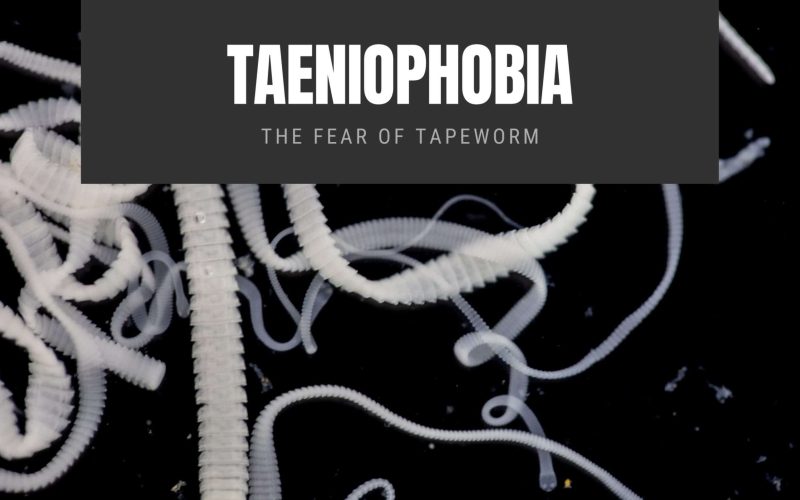Tapeworms are segmented flatworms that resemble measuring tapes, hence the name. They are parasitic organisms that live in the intestines of some animals and cause tapeworm infections.
While animals can become infected by grazing or drinking contaminated water, humans become infected by eating undercooked tapeworm-contaminated meat.
Tapeworm infection can cause a range of disturbing symptoms; like certain infections, it is feared. However, when fear of tapeworms becomes extreme and irrational, taeniophobia is said to have been developed.
Taeniophobia is the extreme fear of tapeworms. With a handful of unpleasant symptoms, this condition can be life-limiting when severe. Fortunately, it is treatable.
The term taeniophobia originated from the Greek words “taenio,” which means “tapeworm,” and “Phobos,” which means “fear.”
Taeniophobia is referred to as a specific phobia, which is defined as the irrational and intense fear of tapeworms.
Taeniophobia, also known as Teniophobia, is associated with the terms “Helminthophobia” and “Vermiphobia,” which means “fear of being infested with worms,” and the word “Scoleciphobia,” which means “fear of worms.
Causes of Taeniophobia
Generally, experts believe that phobias result from some predisposing factors that can contribute to the development of the condition.
These factors are as follows:
- Heredity and genetics: Experts believe that if specific health conditions can be inherited from an ancestor, then it is very much possible that phobias, including Taeniophobia, can be inherited, too.
- Presence of other phobias: The presence of other phobias could lead to the development of Taeniophobia. Phobias such as Helminthophobia, Vermiphobia, and Scoleciphobia can cause taeniophobia due to the strong relationship between them.
- Unpleasant experiences: Trauma is noted as one of the most common causes of phobias. An unpleasant event can leave an indelible mark on a person, which can go a long way in denting a person’s life. Taeniophobia is likely to develop after a tapeworm infection or even the sight of a tapeworm.
- Background upbringing: They say that an individual’s environment significantly influences the well-being, beliefs, and attitudes of the person. A child that grows up in an environment where there are several cases of tapeworm infection. The awful sight of people being sick with a tapeworm infection may lead him or her to believe that tapeworm is dangerous. A sensitive child may even hear stories, including ill-informed ones, and may develop an irrational fear of tapeworms.
Experts suggest that this condition’s development may result from the above-mentioned factors.
Symptoms of Taeniophobia
The symptoms of phobias vary depending on the degree of fear that the person feels. These symptoms can interfere with someone’s usual day-to-day lifestyle, and the sufferer’s social life is also highly affected.
These symptoms manifest in two forms: physically and psychologically.
Physical Symptoms
People with Taeniophobia frequently have panic attacks when triggered. The panic attacks that they experience can be so frightening that it puts the sufferer in a state of distress.
Although sufferers must be triggered before they experience some symptoms accompanying this condition, these symptoms can come anytime without warning.
Panic attacks can be so overwhelming to an individual that they cause bodily reactions such as:
- Excessive sweating
- Trembling
- Hot flushes
- Difficulty breathing
- A choking sensation
- Rapid heartbeat
- Sharp chest pain
- A feeling of butterflies in the stomach
- Nausea
- Headaches and dizziness
- Feeling faint
- Nerve numbness
- Dry mouth
- A need to go to the toilet
- Ringing or buzzing in ears
- Confusion
- Hyperventilation
- Increase in blood pressure
Psychological Symptoms
In a handful of very severe cases, when a patient is exposed to anything that can cause him or her to get triggered, the following are psychological effects experienced:
- Fear of losing control
- Fear of fainting
- Feelings of dread
- Fear of death and dying
- Fear of harm or illness
- Guilt, shame, self-blame
- Withdrawing from others
- Feeling sad or hopeless
- Feeling disconnected
- Confusion, difficulty concentrating
- Anger, irritability, mood swings
- Anxiety and fear
There are also rare cases that affect people, called “Complex phobias.” A complex phobia is like a chain of phobias linked together.
This could be so overwhelming that the individual would not be able to live a normal life and maintain a healthy social life.
Once such persons are triggered, he or she is bound to have a chain of the symptoms mentioned above, including depression.
Treatment of Taeniophobia
As in other phobias, sufferers always feel the need to avoid encountering their source of fear. This would mean they won’t get triggered, but sometimes, this is difficult and likely impossible. Mind you, most of the time, you cannot escape your thoughts.
No treatment available is guaranteed to cure phobias, but therapy and medications may be adopted to help you recover. Majorly, it depends on the individual and the severity of the condition.
Professional help is needed to treat taeniophobia. A mental health worker may be consulted to help you overcome taeniophobia.
Yoga/Meditation
Meditation is a relaxation technique that helps calm the mind, allowing the practitioner to escape negative thoughts and obtain inner peace.
While you take deep breaths, your mind is channeled to something more positive and productive.
Support Groups
You may sign up for a support group, including a DBT group. Dialectic Behavior Therapy (DBT) is a six-month program consisting of classes that teach people many coping skills and better control of themselves when faced with the source of their fear.
You may also sign up for the Mindfulness-Based Stress Reduction (MBSR)program, which is an eight-week program consisting of group sessions where mindful meditations are practiced. Later, a group discussion is held for everyone to talk about mental health.
In this program, you will meet people like you, and with the support of the group coach, you will pull through and eventually recover.
Therapy
Meeting with a mental health professional can help you recover from Taeniophobia. Keeping up with your scheduled sessions with your therapist in a serene, comforting, and discreet environment will contribute to your recovery.
Your therapists are likely to use this approach below to achieve the desired aims:
Cognitive-behavioral therapy (CBT): Experts suggest that our thoughts and perceptions substantially and consistently influence our behavior.
The constant experiences of anxiety, mental stress, and distress influence your attitude and distort it from reality.
Cognitive Behavior Therapy helps you identify negative thought patterns and unhelpful distorted perceptions that cause you to fear and then equips you with strategies to help you overcome them.
Use of Medicines
The use of medicines is not the cure for taeniophobia, but because of their calming effects, they are used to help suppress the symptoms of Taeniophobia.
The following are the two types of medications used in the treatment of phobias, specifically Taeniophobia.
- Anti-anxiety Drugs: This is a family of medicines known to lower anxiety by forming bonds with the receptor cells of the brain (which are responsible for these extreme symptoms). Anti-anxiety drugs include Valium.
- Anti-depressant Drugs: This family of drugs is widely used to treat depression, but they are regarded as useful in the treatment of phobias. This is because they are known to reduce anxiety. They include medicines such as Lexapro.
Note: These medications should be used only when prescribed, and the instructions should be followed strictly.
These drugs are likely to cause some side effects to some people. They should be prescribed to be used short-term only because long-term use can result in addiction and dependence. Do not self-medicate.
We hope that this article has been helpful. Kindly leave a comment below.








